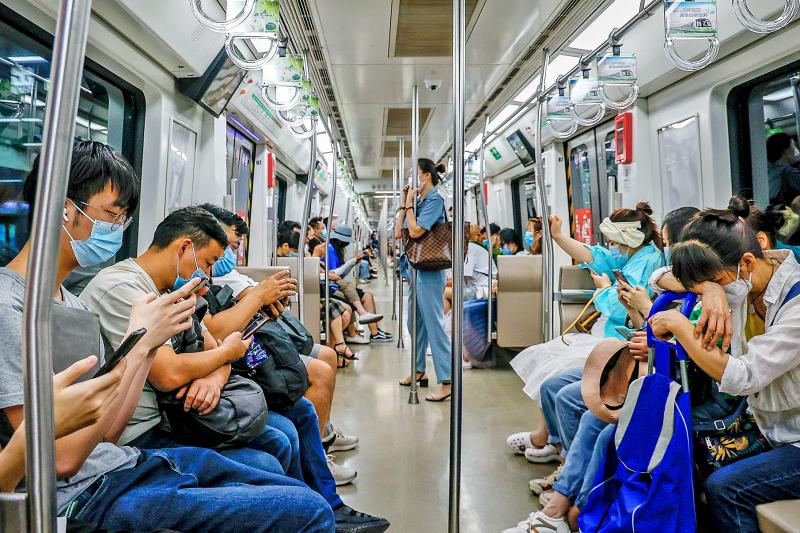A Beijing man is under criminal investigation after he skipped out on mandated home isolation, prompting authorities to send his more than 5,000 neighbors into home or government quarantine. The actions by the man, who later tested positive, come as the Chinese capital and Shanghai begin to ease restrictions.
Officials yesterday said the man, in his early 40s, had been told on Monday last week to isolate at home after he entered a shopping plaza deemed a risk area. They alleged that during his period of isolation he “went out many times, and moved in the community, risking the spread of the epidemic,” before he and his wife tested positive five days later.
In response, authorities ordered 258 people who lived in his building to go to a government quarantine center, and the more than 5,000 others who lived in the residential community to stay at home.

Photo:EPA-EFE
China has imposed harsh curbs on its population as it works to eliminate outbreaks of the highly transmissible Omicron variant of SARS-CoV-2. China’s “zero COVID” policy has come under criticism for its significant negative impact on the economy and people, particularly in Shanghai, but Chinese President Xi Jinping (習近平) has doubled down on demands that it continue, and succeed.
The strict measures have sparked widespread frustration and exhaustion among residents, but with reported case numbers now dropping and restrictions beginning to ease, online people reacted angrily to the actions of the Beijing man.
“It’s been two days since it’s been cleared, what is this man doing? Doesn’t he want to clear the epidemic in Beijing? Does he have to come out and harm people when the situation is almost stable?” one commenter said.
“The community and the patient each share 50 percent responsibility, as the community did not install a door magnetic alarm... and there was a management responsibility which the community should shoulder,” another said.
On Sunday, authorities reported 122 new community cases across the country, outside quarantine settings and including 102 asymptomatic carriers.
In Beijing just 12 locally transmitted cases were reported on Sunday, and libraries, museums, theaters and gyms were allowed to reopen in areas where there had been none for at least seven days.
Beijing authorities had sought to avoid a mass lockdown, but instead imposed travel curbs, enforced working from home in some districts, closed public venues, and conducted targeted lockdowns of individual buildings and areas.
In Shanghai, a months-long lockdown is set to end tomorrow, and the government has announced a swathe of economic stimulus measures designed to address damage.
At an unprecedented meeting with more than 10,000 officials last week, Chinese Premier Li Keqiang (李克強) warned the economy was at a “critical point” and that there would be dire consequences if officials did not act swiftly, and balanced COVID-19 controls with economic growth.
Several regions have established “routinized” testing regimes requiring all residents to get a negative polymerase chain reaction result every two or three days to move about with more freedom.

Philippine President Ferdinand Marcos Jr has fired his national police chief, who gained attention for leading the separate arrests of former Philippine president Rodrigo Duterte on orders of the International Criminal Court and televangelist Apollo Carreon Quiboloy, who is on the FBI’s most-wanted list for alleged child sex trafficking. Philippine Executive Secretary Lucas Bersamin did not cite a reason for the removal of General Nicolas Torre as head of the 232,000-member national police force, a position he was appointed to by Marcos in May and which he would have held until 2027. He was replaced by another senior police general, Jose

POWER CONFLICT: The US president threatened to deploy National Guards in Baltimore. US media reports said he is also planning to station troops in Chicago US President Donald Trump on Sunday threatened to deploy National Guard troops to yet another Democratic stronghold, the Maryland city of Baltimore, as he seeks to expand his crackdown on crime and immigration. The Republican’s latest online rant about an “out of control, crime-ridden” city comes as Democratic state leaders — including Maryland Governor Wes Moore — line up to berate Trump on a high-profile political stage. Trump this month deployed the National Guard to the streets of Washington, in a widely criticized show of force the president said amounts to a federal takeover of US capital policing. The Guard began carrying

Ukrainian drone attacks overnight on several Russian power and energy facilities forced capacity reduction at the Kursk Nuclear Power Plant and set a fuel export terminal in Ust-Luga on fire, Russian officials said yesterday. A drone attack on the Kursk nuclear plant, not far from the border with Ukraine, damaged an auxiliary transformer and led to 50 percent reduction in the operating capacity at unit three of the plant, the plant’s press service said. There were no injuries and a fire sparked by the attack was promptly extinguished, the plant said. Radiation levels at the site and in the surrounding

‘DELIBERATE PROVOCATION’: Pyongyang said that Seoul had used a machine gun to fire at North Korean troops who were working to permanently seal the southern border South Korea fired warning shots at North Korean soldiers that briefly crossed the heavily fortified border earlier this week, Seoul said yesterday after Pyongyang accused it of risking “uncontrollable” tensions. South Korean President Lee Jae-myung has sought warmer ties with the nuclear-armed North and vowed to build “military trust,” but Pyongyang has said it has no interest in improving relations with Seoul. Seoul’s military said several North Korean soldiers crossed the border on Tuesday while working in the heavily mined demilitarized zone (DMZ) separating the two Koreas. The incursion prompted “our military to fire warning shots,” South Korea’s Joint Chiefs of Staff